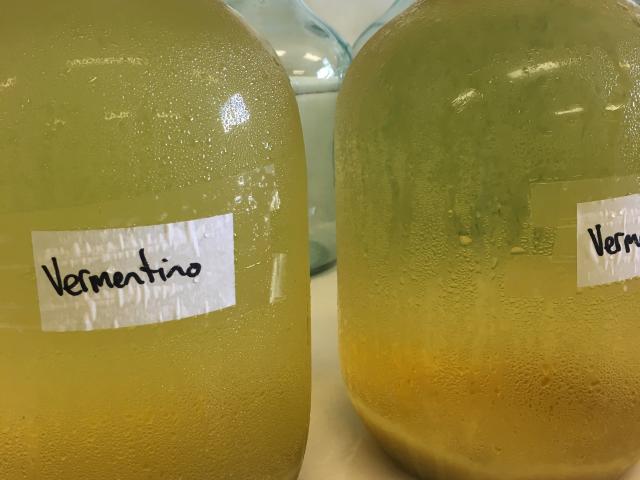DAFWA vintage wrap up
This year two projects involved winemaking components with fruit sourced from the Geographe, Margaret River, Manjimup and Great Southern wine regions.
The national project ‘Assessing clonal variability in Chardonnay and Shiraz for future climate change’ has been extended by Wine Australia (funding body) until June 2018, so that further data can be collected on Chardonnay clones. Five clones of Chardonnay were harvested in Margaret River and six in the Great Southern. As the season was much cooler than previous years the clones where much later maturing as shown in Table 1.
Table 1. Harvest dates of Chardonnay clones over four seasons
| Region | Clone | 2014 | 2015 | 2016 | 2017 |
| Margaret River | 76 | 18 February | 6 February | 10 February | 2 March |
| 95 | 13 February | 4 February | 15 February | 8 March | |
| 96 | 18 February | 6 February | 15 February | 8 March | |
| 277 | 18 February | 4 February | 15 February | 8 March | |
| Gingin | 13 February | 4 February | 10 February | 2 March | |
|
|
|
|
|
|
|
| Great Southern | 76 | 5 March | 24 February | 9 March | 31 March |
| 95 | 5 March | 24 February | 9 March | 31 March | |
| 96 | 5 March | 24 February | 9 March | 31 March | |
| 277 | 5 March | 24 February | 9 March | 31 March | |
| Gingin | 12 March | 24 February | 9 March | 31 March | |
| I10V1 | 5 March | 24 February | 9 March | 31 March |
Applying an average to the picking dates for each of the regions, Chardonnay in 2017 was 23 days later in Margaret River while being 27 days later in the Great Southern. In addition to later ripening, disease pressure was also higher than previous years.
The wines from 2017 will be available to taste through a series of workshops scheduled for later in the year.
The second winemaking project was the evaluation of alternative varieties from a demonstration block at the WA College of Agriculture – Harvey (located in the Geographe wine region). This season’s plan was to evaluate four varieties, but DAFWA was able to pick and process 12 varieties. Table 2 lists the varieties, harvest date, Baume, pH and titratable acidity (TA). The varieties have been made into one or two styles dependant on suitability. Winemaking techniques such as skin contact, yeast selection, fermentation temperature and oak additions have been applied to enhance varietal expression.
Table 2. Harvest data from alternative variety evaluation
| Variety | Harvest date | Baume | pH | TA (g/L) |
| Scheurebe | 27 February | 11.3° | 3.14 | 7.1 |
| Savagnin | 27 February | 13.2° | 3.14 | 8.0 |
| Dolcetto | 27 February | 13.7° | 3.51 | 6.8 |
| Pignoletto | 1 March | 11.0° | 3.08 | 8.6 |
| Fiano | 7 March | 12.0° | 3.06 | 8.2 |
| Vermentino | 16 March | 12.0° | 3.23 | 6.2 |
| Tannat | 16 March | 12.7° | 3.37 | 7.3 |
| Sciacarello | 29 March | 13.4° | 3.30 | 6.0 |
| Arneis | 29 March | 10.1° | 3.23 | 5.9 |
| Carmenere | 11 April | 12.4° | 3.78 | 4.5 |
| Graciano | 11 April | 13.6° | 3.39 | 5.3 |
| Saperavi | 11 April | 13.7° | 3.33 | 6.5 |
In addition to these varieties, DAFWA has 20 vines of Gruner Veltliner at the department's Manjimup Research Facility which produced their first crop this season. Approximately 70kg of fruit was harvested (27 April) and has been made into wine. This wine and the other varieties from Geographe will be bottled by August, assessed at the Geographe Wine Show and made available to industry to taste at a workshop planned for later in the year.

